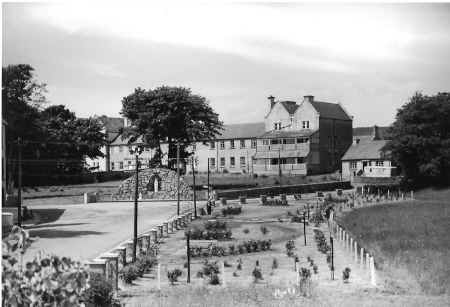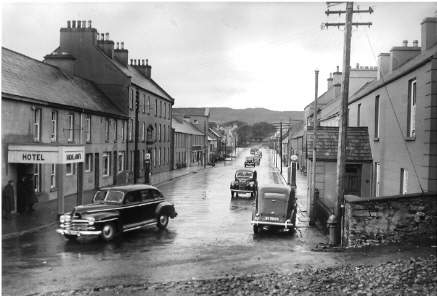History of the School
Author – Keara Nichols

Old Hospital in 1950’s (Photo courtesy of Denis Tynan)
Ireland’s population grew very rapidly after 1800 and reached 8.1million in 1841. The Marquis of Conynghan, an absentee landlord owned most of the land in the Barony and Boylagh which included Glenties and the Rosses. Like many landlords, he left his affairs to agents who collected rent. Most of the farmers were subsistence farmers living on potatoes they produced and some grain they grew or raising a pig and labouring to pay the rent.
One parish was so poor that they only had 2 feather beds, 8 chaff beds, no swine hogs or pigs and only one national school. In response to this situation a Poor Law was introduced to Ireland in 1838. The country was divided into districts or unions and the Glenties Poor Law Union had 13 elected areas- stretching from Glencolumbkille to Kincasslagh – a vast area. These areas elected a Board of Guardians who were empowered to collect a poor rate to build a workhouse and support the local poor.
Workhouses were built to a standard design. Men were separated from women, boys from girls and children from parents. Conditions were uncomfortable and frugal to discourage all but the destitute from entering. In 1842 the Board of Guardians decided to build a workhouse in the Glenties Union at Glenties and a loan of £6,600 was authorised. The building started in 1843 and was finished in 1846. It was opened on the 1st of May.
However, with the widespread failure of the potato crop in the autumn people flocked to the workhouse. By 1847 the workhouse was grossly overcrowded. Reports at this stage speak of the filthy condition of the workhouse, the straw beds being old and musty and the death rate at Glenties being the one of the highest in the country. Outbreaks of dysentery, scurvy and fever were by then a major problem and the fever hospital was built in 1847.
When the Free State took over the facility in 1922, it was named St. Patricks District Hospital. The hospital provided general medical services for the area until the opening of the Dungloe district hospital in 1958. During the 1950’s part the hospital was used as a Sanatorium in Dr. Noel Browne’s T.B scheme.

Glenties in 1950’s (Photo courtesy of Denis Tynan)
The school established in Glenties was one of the first four Comprehensive schools set up in the country at the end of 1960’s.
Glenties was chosen as a location for a Comprehensive school because it already had a vocational school and it was the centre of a large catchment area that would have the required number of students necessary for a viable Comprehensive school.
The old hospital in Glenties seemed to be a suitable site. The hospital was sold to the Department of Education as the site for the new school.
A price was fixed for the hospital site. A nominal fee of 100 pounds was to be paid and 300 pounds compensation to the County Council for having to move their engineers yard, which adjoined the site, to another location.
The official opening of the school took place on Wednesday, 20th November 1968. There was an intake of 314 pupils.
